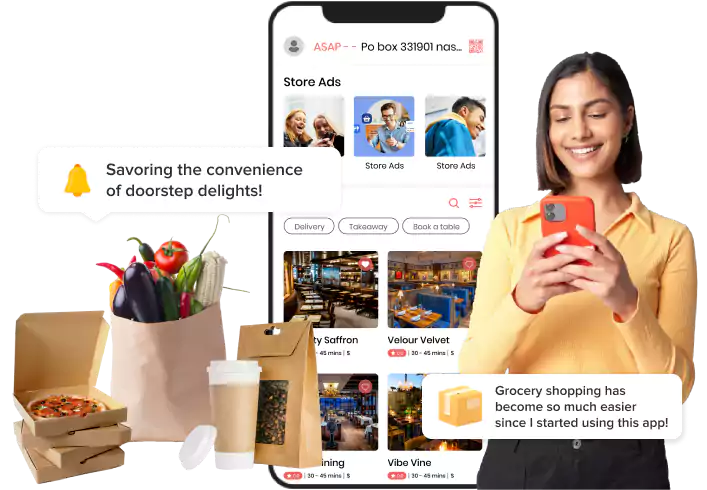Complete List Of Our EDelivery Store Panel Features
A complete store management view with extended support getting all the inclined features.

Quick Login with Phone or Password
Stores can log in to the platform directly using the phone and password within a single step.
Register with Details
Stores can sign up with detailed information asked on the screen, like name, email, country, etc.
Quick Social Signup
Stores can use their social credentials to register in the app or panel, like Facebook, Twitter, or even their Google ID.
Login as Store or Sub Store
There are two types of store accounts – one is a store, and another is a sub store which they can choose while logging in.
Reset Forgot Password
In case the password is lost, it could be recovered using the email address registered with or with the phone number.
Add Referral for Benefits
Stores can add a referral code while registering, and if they have any of the accounts that are already registered and both will get benefits.
Upload Documents
As required by the admin, stores have to add specific documents while registering to the platform, which will be verified.
Add Bank Details
For transactions within the platform, stores can add bank details which can also link to the wallet integrated into the platform, to settle up the payments.
Manage Profile
Stores can make changes to their profile details like name, email, password, contact details, location, etc.
Select Languages
Stores get multiple languages to use the app as given by the admin; they can choose one convenient language.
Change Password
Stores can update the password anytime they want from the profile details adding old and new passwords.
Delivery Time Settings
Stores can update the delivery time availability of the stores in a week which will be shown to the customers.
Store Time Settings
Stores can update the store’s service time availability of the stores in a week which will be shown to the customers.
Create Menu – Item, Modifier, Price
The store can create the menu by adding items, categories, sub-categories, modifiers, and all required details.
Modifier Association
In modifier association, the store can associate various groups of modifiers groups which customers can choose accordingly.
Add Categories/Subcategories
A category is a group of items with various similar items which will sort the large items in the menu, reducing the search friction for customers.
Create Substores
Stores can create substores profiles that can access only assigned screens from the store panel.
Add and Manage Delivery Provider
Stores can add their own delivery providers, create accounts for them, and register a vehicle for them, which will be approved by the admin.
Create and Update Promo Codes
Admin can create promo offers for a time interval set for the customers and apply conditions, setting a recurring time interval.
Create an Order (Parcel, Takeout, or Delivery)
Stores can create orders for the customers depending on the type of order, like parcel, takeaway, and delivery, with the customer’s details.
Order List
Stores get all the order lists separated by time, like today’s orders, tomorrow’s orders, scheduled orders, etc.
Dispatch Orders
Stores can dispatch the orders with two different methods, either assigning the orders manually or auto-assigning to the available and nearest drivers.
Current Week History, Current Month History
All the store’s history about the orders is stored separately as week or month history.
Analyze Order and Delivery Reviews
The store can analyze the reviews about the order and delivery service given by the customers.
Earnings- Weekly, Monthly, and Overall
All the store’s earnings from the orders and delivery service are stored separately as week or month history.
Import and Export Data Sheets
Menu, order list, earnings, and all such lists are imported to the sheet or even exported from the sheet for offline use.
Chat with Deliverymen
Store owners can chat with the delivery for any inquiries about the order, delivery service or addresses, etc.
Order Cancellation Settings
Store owners can decide to set the order cancellation charges, setting the charges that are applied at various stages of the delivery process.
Free Delivery Settings
Stores can set free delivery to the customers with the conditions of minimum ordering amount and radius of the delivery from the store.
Reserve Tables Settings
Restaurants can allow customers to book a table online, reserve tables as per the individuals, and also set reservation and cancellation fees.
Cancel Table Booking Setting
Restaurants can set the charges for canceling the table booking and orders depending on various factors.
Stores can Print Invoice
Stores get to print the invoice from their order lists, connecting the printer with Bluetooth, which they can use for offline purposes.
Multi Tax Setting
While creating a menu, stores can set multiple taxes for each item. They can also set taxes for all items and services separately.
Order By Scanning the QR Code
Stores can add a table and download its QR, which customers can use to access the menu and order without logging in to the app or panel.
Menu Themes By Admin
Admin can set stores the menu theme between the default row view menu or grid view menu to show it to the customers.
Various Themes
Stores can choose to keep the themes of the panel from various options keeping light and dark themes matching the logo and store theme.
Select Tags
Stores can set the tags based on the items they sell, allowing customers to choose a tag in order to reduce browser fiction.
Store’s General Settings
Stores can manage general settings like business status, visibility, and also if the store will be visible or not to the customers.
Get Multiple Payment Gateways
The store panel and app are integrated with multiple payment gateways like Stripe and Paystack, supporting the payment system in multiple countries.
Deliver Parcel
Stores can create an order for the customers to deliver the parcel to their desired address.
Want to build a high-tech product? Check what we can do for you.
Book a Free Call